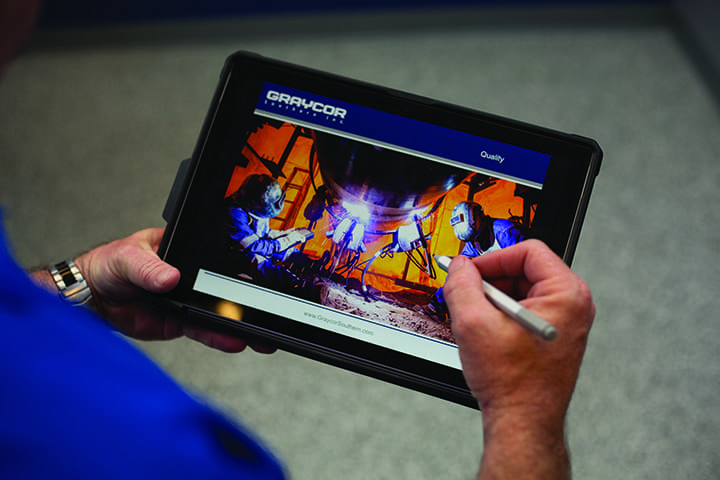Technology in Construction: Choosing and Implementing Solutions
In Part I of this three-part series, which was published in the May 2020 issue of POWER and titled “Technology in Construction: Predicting and Adapting to Change,” recent trends in technology adoption across the construction industry were examined. This month, Part II relays proven advice on how a company can select and roll out relevant tools.
The world is at a pivot point in history where technologies ranging from computers and software to physical robots are dramatically shifting job roles and responsibilities. Many construction and power companies know that greater adoption of technology for capital and maintenance projects is inevitable, but they are struggling to find efficient, minimally disruptive ways to identify and integrate the best of what is available.
A common approach for companies is to let their employees try new products at will, hoping the best solutions will “float to the top.” However, this usually results in chaos. Typically, every employee has a different favorite tool, creating a cacophony of patch-together solutions. Furthermore, having competing systems in play results in data being limited to the project level rather than being funneled to corporate decision-makers, eliminating the opportunity for those systems to provide high-level insights and enable more comprehensive planning. Investing in multiple systems can cause costs to get out of control too.
A Strategy for Success
The correct strategy is to foster a culture of innovation and growth while holding fast to discipline and documentation. Testing, not committees, should decide which tools to adopt, and clear communication between both “boots-on-the-ground” and corporate departments should be prioritized.
Implementing pilot programs will result in an organized approach that tracks not just flashy new tools, but the business problems companies are trying to solve. Pilot programs prevent confusion, competing systems, and overbuying. They also provide a framework for documentation.
The goal of documentation is to capture as much information as possible in writing, including why a new tool is expected to be better than the current status quo, specific goals for the tool being tested, and a time horizon for when those goals should be met. Goals can include whether a tool will make a current process faster or cheaper, whether it will provide the customer with better information, or if it will make the end-product more valuable for the same price. Holistic financial ramifications should also be addressed; for example, will a given tool help field staff, but put an extra burden on IT? If a piloted tool is not meeting anticipated goals and is not providing value, the team should be quick to document lessons learned and put the tool on the shelf.
Corporate departments should be modified to help facilitate pilot programs by creating test environments, identifying core user groups who will execute the program, and coaching people in how to properly document the piloting processes. Some companies choose to create a new position, where the job description includes serving as a clearinghouse and centralized communications hub for new operational technology initiatives and for the research required to test, pilot, and assess the value of the efforts. One benefit of having a dedicated employee is that they can commit time to staying abreast of the latest advancements, including attending construction technology industry events. Specialized employees also make excellent vendor liaisons.
No matter how a company structures its pilot program, it should begin by developing a strategic vision. Create a road map to outline steps. Form an executive committee to set and oversee benchmarks. On-site teams can execute the details of the road map. Detailed internal implementation processes should be established to make sure that tools with value can be scaled quickly and effectively. Communication is critical. Written communication plans to inform staff of what is being piloted, as well as major successes and failures, should be in place.
Where to Start
Corporate-level efforts should not focus too much on committee review or approval of specific tools; this can kill grassroots innovation. However, it will help to sort through the noise and identify early in the planning process which categories of technology are changing the industry. While there is a lot of change, a few key concepts and/or technologies are currently acting as central drivers to the growth of other, secondary technologies: the digitization of information, increased use of mobile, building information modeling (BIM), and unmanned vehicles.
Digitization of information needs to be the first step down the technology path. Beginning by digitizing information, as well as capturing and owning as much data as possible, is a necessary first step to prepare for the future. For the construction and power industries, digitized information should include putting drawings and specifications in PDF format, combining data in spreadsheets and databases, assembling building information using BIM, and digitizing project controls like cost and schedule in more specialized tools than common spreadsheet software.
Some file formats are more advantageous than others, and employees should be trained to understand the difference. For example, consider a raster PDF set of drawings versus a vector-based set. Raster files are based on bitmaps that track specific “dots” and color intensity, similar to how a newspaper image is created. Vector information tracks lines, circles, other shapes, letters, numbers, words, etc. Vector data is much more powerful while also typically being a much smaller file size.
 |
|
1. Mobile devices allow workers to have vital information at their fingertips when they’re out in the field. Courtesy: Graycor |
A robust mobile strategy is key (Figure 1). Contractors do not build projects at desks or in front of computers. Not only is their most productive time spent in the field, but key decisions are made there. Giving staff mobile access to information and data is foundational. Without mobile devices, companies cannot gain full benefits from other technologies, and this will be even more true as tech tools get stronger and faster, and more and more data is passed back and forth.
BIM is essential when it comes to the digitization of information about buildings. It functions as much more than a 3D drawing. It is also more than clash detection. BIM is a process that begins to take advantage of technology in order to comprehensively analyze a building design, affording insights and increasing the value companies can provide their customers. BIM models, once developed, have uses including, but not limited to, site utilization planning, digital fabrication, survey and locations control, model qualification, and in the case of the recently discussed “digital twin” (when turned over to owners) facilities management.
Virtual design and construction (VDC) and 4D tools can be used in conjunction with BIM. 4D planning incorporates the component of time by simulating construction sequencing. When linked with the BIM model, 4D information can be used to evaluate and validate schedules.
Like BIM, VDC is not an individual piece of software, nor is it just clash detection, but instead, it is a process to help plan and manage a project that focuses on collaboration and integrated workflows. It can leverage various software and hardware tools, including tools to author and analyze the model as well as new tools for viewing the models, such as virtual or augmented reality. When assembling a suite of software to experiment with, subscribing to software as a service (SaaS) harnesses the flexibility and storage capacity of the cloud, keeping up-to-date information available to off-site workers.
Unmanned aerial vehicles (UAVs), or flying quadcopters, are the most familiar drones today. But a few companies are also developing land-based robots to navigate project sites. Both aerial and terrestrial drones/rovers navigate independently and can be used to gather photographic data, light detection and ranging (LIDAR) scan data, and other sensor data, as well as be used to deliver items from place to place. There are many simple tasks that drones can help with today, but they require both regulatory knowledge and an understanding of the hardware and software used.
A first step in any company’s successful adoption of technology is to incorporate these fundamental tools—the ones upon which other technologies rely. By integrating them into simple workflows today, using a top-down, structured approach, project teams can prepare for and evolve with developing technologies.
 |
|
2. Most companies already have computer-based systems for many of their operational needs such as safety programs, scheduling tools, and maintenance management systems. However, when upgrades are necessary, pilot programs can help ensure the best new technology is selected. Courtesy: Graycor |
It can be helpful to set up the company’s pilot program in a way that separates goals into two categories: operational technology, and research and development (R&D). Operational technology goals focus on tools that provide immediate value to project teams, with technologies that are already in use internally (Figure 2). R&D goals are aimed at testing unproven technologies.
Proceeding with Caution
While it’s important not to fall too far behind in the “race” to keep up with technology and stay competitive, it should also be remembered that a measured approach—one with the same level of strategy and sophistication a company brings to its other endeavors—is critical for long-term success. Many messages in the marketplace can challenge this type of systematic approach.
Information overload is one problem, as more and more technology startups hit the market. Construction and power companies may also experience the “fear of missing out,” which is heightened if there is also concern that missing out translates to a loss of competitive edge. It is important to remember, too, that much of what tech companies say about their products are embellished and can be misleading. Similarly, competitors may appear to have everything figured out, but in reality, most are still discovering how technology fits into their workflows. Understanding what is real and what is marketing hype can be a real challenge.
As with most business endeavors, planning, communication, and documentation are the secret to success. A solid pilot program can put any company on the path to successful technology adoption.
Part III of this series, scheduled for publication in the September 2020 issue of POWER, will focus on matching technologies to specific challenges. A handful of use cases will be included. ■
—Weston Tanner is director of Construction Technology and Innovation with Graycor.